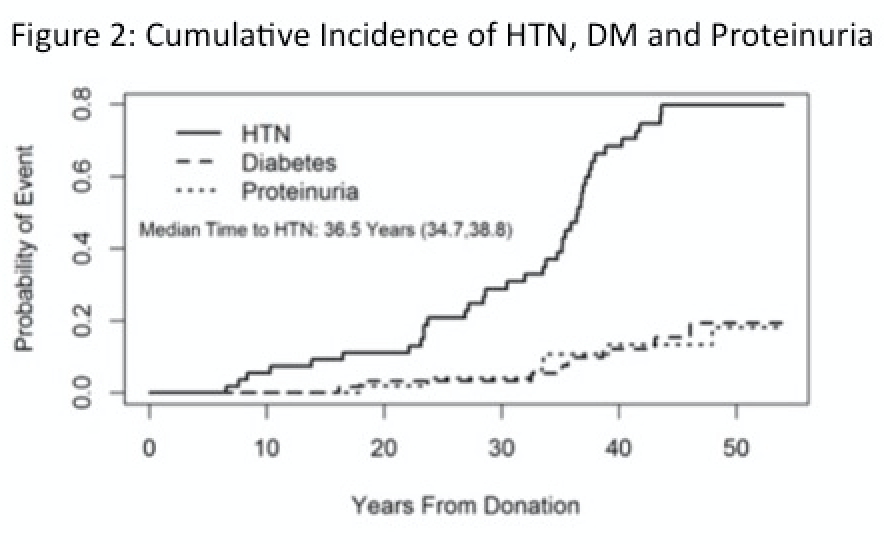Kidney Donor Outcomes ≥ 50 Years Post Donation
University of Minnesota, Minneapolis, MN
Meeting: 2019 American Transplant Congress
Abstract number: 224
Session Information
Session Name: Concurrent Session: Kidney Donor Selection / Management Issues II
Session Type: Concurrent Session
Date: Monday, June 3, 2019
Session Time: 2:30pm-4:00pm
 Presentation Time: 3:30pm-3:42pm
Presentation Time: 3:30pm-3:42pm
Location: Ballroom C
*Purpose: Data on true long-term follow-up (LTFU) of living kidney donors (LD) is sparse. Given this, the acceptance of young donors can be a challenging feature of living donor selection. We describe outcomes of a cohort of donors that donated ≥50 years ago at our institution.
*Methods: We have a longstanding database to track long-term LD outcomes and have developed methodology to maintain regular contact with our LD population. As a result, we can carefully document the onset of individual morbidities.
*Results: Of the 66 donors who donated ≥50 years ago, 5 have been lost to follow-up a mean of 39 years after donation at a mean age of 68.7. Of the 61 with known information, 22 survived at least 50 years postdonation and 39 died before 50 years post donation. Median survival post donation was 44.1 years. The baseline characteristics of the 61 donors with LTFU information are shown in Table 1. By univariate the only significant difference in those still alive compared to those who died was younger age at donation (p<0.001). By Cox PH regression for mortality there were no significant differences between groups. KM mortality curve is shown in Figure 1. The incidence of mortality at 50 years post-donation was 63.9% overall with mean (SD) age at death of 74.2 (12.3): 25.2% CVD, 75.6 (12.6); 9.8% infection, 76.5 (11.6); 12.3% malignancy, 70.9 (6.0); and 23.8% other/unknown, 73.5 (14.1). Figure 2 shows the cumulative incidence of HTN, DM and proteinuria. HTN developed in 79.7%, mean age (SD) of 59.9 (14.8); diabetes in 19.3%, 62 (19.4), and proteinuria in 18.1%, 60.6 (18.2). Two donors (3.3%) developed ESRD; 1 hypertension and 1 hemolytic uremic syndrome.
*Conclusions: Of 66 donors who donated more than 50 years ago, 5 were lost to follow-up. In the LTFU cohort, 22 (36%) survived ≥ 50 years and 39 (64%) died. The main cause of death was CVD. HTN was the most common post donation comorbidity, with half of donors developing the condition by 36.5 years post. Two patients (3.2%) developed ESRD.
To cite this abstract in AMA style:
Keys D, Jackson S, Matas A. Kidney Donor Outcomes ≥ 50 Years Post Donation [abstract]. Am J Transplant. 2019; 19 (suppl 3). https://atcmeetingabstracts.com/abstract/kidney-donor-outcomes-%e2%89%a5-50-years-post-donation/. Accessed December 17, 2025.« Back to 2019 American Transplant Congress



